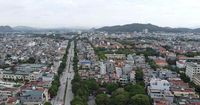On April 4, 2025, during the 23rd Conference of the Executive Committee of the Hai Duong Provincial Party Committee, the Provincial Standing Committee presented a comprehensive proposal regarding the principles, criteria, and plans for the rearrangement and reorganization of administrative units at the commune level. This initiative aims to streamline the administrative framework in Hai Duong province, which currently encompasses 207 commune-level administrative units.
The proposal outlines a significant reduction in the total number of these units, projecting a decrease to approximately 50% of the current count. This means that Hai Duong will see a consolidation of its administrative structure, which is expected to enhance governance efficiency and improve service delivery to citizens.
According to the report from the Provincial Standing Committee, the new administrative units will be structured to ensure a reasonable correlation in population and land area, avoiding significant disparities between the newly formed communes and wards. The headquarters for the new administrative units will be strategically chosen from existing central administrative units, ensuring they are located in areas with robust socio-economic infrastructure, particularly in terms of transportation connectivity.
In terms of naming these new administrative units, the committee emphasized the importance of simplicity and memorability. Names will be linked to district-level units and will retain historical and cultural significance. Each unit will also be numbered, prioritizing areas that are central to development and urban growth.
The criteria for establishing new communes will require that they possess a natural area and population size that meets or exceeds 200% of the standards set forth in the National Assembly's Resolution on administrative units. Specifically, a new commune will need a minimum area of 42 square kilometers and a population of at least 16,000 people. For wards, the requirements are slightly different, necessitating a minimum area of 15 square kilometers and a population of at least 30,000.
Interestingly, if three or more existing administrative units are merged into a single new unit, the strict criteria regarding area and population do not apply. This flexibility is intended to facilitate the merging process while still achieving the overarching goals of administrative efficiency.
The Politburo and the Secretariat have tasked the Government with developing specific criteria for the rearrangement of these administrative units, which will be presented to the National Assembly Standing Committee for further consideration. The Hai Duong Provincial People's Committee has already begun drafting plans in anticipation of this directive.
In a related development, at a recent meeting on March 28, 2025, General Secretary To Lam emphasized the need for a lean and efficient political system. This meeting, held in Da Nang, commemorated the 50th anniversary of the Liberation of the South. He highlighted that the administrative apparatus would be restructured into three levels: Central, provincial/city, and commune/ward.
Initial projections suggest that the number of provinces and cities in Vietnam will decrease from 63 to approximately 34. This restructuring will involve maintaining 11 provinces and cities as they currently are, while merging 52 others based on established criteria. Furthermore, the district-level government is set to be dissolved, with the number of commune and ward levels expected to be reduced to around 5,000, a significant drop from the current 10,035.
The Ministry of Interior is actively working on the legal framework necessary for these changes, having received input from various provincial and city Party committees and central departments. They have been developing and finalizing drafts for the National Assembly Standing Committee's Resolution on the rearrangement of administrative units.
According to the Ministry, the restructuring of commune-level administrative units is not merely about adjusting boundaries but is a strategic initiative aimed at enhancing the long-term and sustainable development of the nation. This process will also involve a thorough assessment of historical, cultural, and geographical factors, as well as considerations related to national defense and security.
The criteria for the rearrangement, as outlined in the draft resolution, include natural area, population size, historical and cultural significance, economic geography, and national security. The goal is to create a more effective and efficient local governance structure that is closer to the people and better able to meet their needs.
As part of this initiative, the Provincial Standing Committee has called for widespread communication regarding the Central and provincial policies to foster consensus among the political system and the public about the administrative rearrangement. This includes enhancing awareness and responsibility among government leaders and officials regarding the changes.
Moreover, the committee is keen on addressing the policies related to the personnel involved in these administrative changes, ensuring that the rights and interests of civil servants are respected during this transition.
With the aim of having the new administrative units operational by July 1, 2025, the Hai Duong Provincial Standing Committee is committed to submitting a comprehensive plan to the appropriate authorities in a timely manner. This process is viewed as an opportunity to streamline the government structure, improve the effectiveness of local administration, and ultimately enhance the quality of life for residents.
In summary, the proposed restructuring of administrative units in Hai Duong province marks a significant step towards creating a more efficient governance model. As the province prepares for these changes, the emphasis remains on ensuring that the new administrative framework is not only effective but also responsive to the needs of its citizens.






